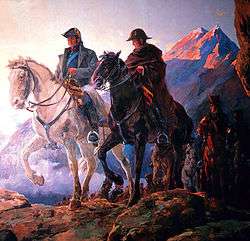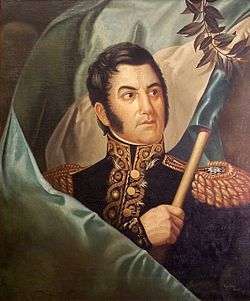Santiago de Liniers, 1st Count of Buenos Aires
| Santiago de Liniers | |
|---|---|
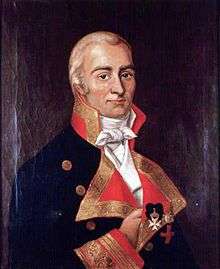 Santiago de Liniers | |
| 10th Viceroy of the Viceroyalty of the Río de la Plata | |
|
In office February 10, 1807 – June 30, 1809 | |
| Monarch | Charles IV of Spain – Junta of Seville |
| Preceded by | Rafael de Sobremonte |
| Succeeded by | Baltasar Hidalgo de Cisneros |
| Personal details | |
| Born |
Jacques de Liniers July 25, 1753 Niort, France |
| Died |
August 26, 1810 (aged 57) Cabeza de Tigre, Córdoba |
| Political party | Royalist |
| Spouse(s) | Martina de Sarratea (1772–1805), the elder sister of Manuel de Sarratea |
| Domestic partner | Ana Perichon between 1806 and 1808 |
| Occupation | Naval officer |
| Religion | Catholic |
| Signature |
|
| Military service | |
| Allegiance |
|
| Battles/wars | British invasions of the Río de la Plata, Liniers Counter-revolution |
Jacques de Liniers (July 25, 1753 – August 26, 1810[1]) was a French officer in the Spanish military service, and a viceroy of the Spanish colonies of the Viceroyalty of the Río de la Plata. He is more widely known by the Spanish form of his name, Santiago de Liniers. He was popularly regarded as the hero of the reconquest of Buenos Aires after the first British invasion of the Río de la Plata, which led to his designation as viceroy, replacing Rafael de Sobremonte. Such a thing, the replacement of a viceroy without the King's direct intervention, was completely unprecedented. He was confirmed in office by Charles IV of Spain, and endured a second ill-fated British Invasion attempt and a mutiny that sought to replace him. He was replaced in 1809 by Baltasar Hidalgo de Cisneros, appointed as viceroy by the Junta of Seville, and retired from public activity. However, when the May Revolution took place, Liniers decided to come out of his retirement and organized a monarchist uprising in Córdoba. However, Liniers was defeated, captured, and executed without trial.
Biography
Early life
Santiago de Liniers y Bremond, Cavalier of the Order of San Juan, Cavalier of the Order of Montesa, Captain in the Spanish Royal Navy was born in Niort, France, 4th son of Jacques Joseph Louis, comte de Liniers (1723–1785) captain of the French Navy, and Henriette Thérèse de Bremond (1725–1770).[2]
Family Liniers is one of the most antique noble French family, known since the 11th century. One of its ancestors, Guillaume de Liniers died in the Battle of Poitiers (1356), and eight of his members were Cavaliers of the Order of San Juan.[3]
In 1765, when he was 12 years old, as a younger son, he entered the military school at the Order of Malta, where after three years he graduated with the Cross of Cavalier (1768). Then, he became Sub-Lieutenant of Cavalry in the Royal-Piémont Regiment in France.[4]

Serving the Spanish Crown
In 1774 he requested dismissal and re-enlisted as a volunteer in the campaigns against the Moors in Algiers. He benefited from the third Pacte de Famille (1761), that allowed Frenchmen to take part in Spanish military campaigns with equal rights and requirements as the Spaniards. At the campaign's conclusion he took an exam as a Midshipman in Cádiz, to serve as a volunteer for the Spanish Crown. In 1775 he earned the rank of Ensign.[6]
In 1776, under the orders of Pedro de Cevallos, he sailed to the Viceroyalty of the Río de la Plata and took part on the occupation of Santa Catalina Island (Spain) and the attack on Colonia del Sacramento (modern day Uruguay).[7]
In 1779, he was an officer on the San Vicente, of the Spanish-French Naval Squadron fighting the Royal Navy when Spain jointed the Franco-American alliance in the American Revolutionary War as a renewal of the Bourbon Family Compact. The American Revolution allowed him to stand out professionally. In 1780, with a few sloops, he captured a three-masted ship of 24 guns. In 1782, he distinguished himself particularly in the siege of Port Mahon: under fire, he moved to the collision of two British ships laden with arms and ammunition, seized it and conveyed it to the Spanish lines. This earned him promotion, to Frigate Captain.[8]
A few months later Liniers took part in a new expedition, this time against the city of Algiers, during the First Barbary War and the Second Barbary War. The campaign did not go well for the Spanish navy, and Madrid tried to negotiate instead. Liniers was trusted with this mission. The king of Trpoli was delighted with Liniers, and agreed to free several European prisoners.[9]
The Spanish court rewarded him for this diplomatic success by promoting him to the rank of captain and entrusting the command of the Río de la Plata in 1788 to organize a flotilla of gunships. He took with him his son Luis and his first wife, Juana de Menviel, whom he had married in Málaga. She died two years later in 1790. Liniers married again, this time in Buenos Aires, María Martina Sarratea, daughter of one of the richest merchants of Buenos Aires.[10]
First British Invasion
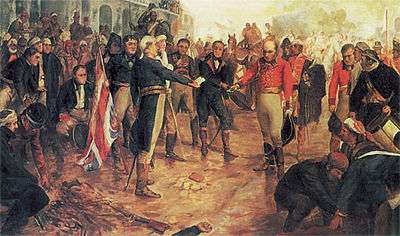
The Napoleonic Wars expanded to South America. Britain got naval supremacy with the victory at the battle of Trafalgar and France within the European continent. France attacked Britain by imposing the Continental System, locking the continent to British trade. Needing new markets, Britain attacked Buenos Aires and Montevideo, two Spanish colonies in South America (Spain was allied to France in the war). Home Riggs Popham attempted to invade Buenos Aires, without official orders. He was aware of the conditions: if he succeeded, Britain would honour his deed, but if he failed, he would be condemned for it.[11]
June 23, 1806, a British expeditionary force of 1,700 men landed on the left bank of the Río de la Plata and invested Buenos Aires, which had been abandoned by the Viceroy. Liniers remained incognito in the city, staying in the convent of the Dominicans, where he vowed to offer at the altar of the Virgin the flags of the occupiers. He then secretly escaped to Montevideo, and with the help of its governor Pascual Ruiz Huidobro galvanized the people and raised a troop of 1,200 volunteers. This Early Liberation Army embarked on a few schooners, which joined a French privateer corvette. Landing on August 4, Liniers and his men rushed to Buenos Aires, across the marshes. The city was recovered after fierce street fighting that ended with the storming of the cathedral, which had been fortified by the British. British General William Carr Beresford capitulated and offered his sword; true to Liniers's vow, British flags (those of the Highlanders regiment and Green St. Helena) were transferred to the church of the convent of the Dominicans, where they still remain.
.svg.png)
Designation as viceroy
After the victory, the society stayed on military alert, suspecting that the British might counterattack soon. The Buenos Aires Cabildo called an open cabildo to discuss the next steps, including the actions to take regarding viceroy Sobremonte. It was decided to keep the viceroy from entering the city and appoint Liniers, who was regarded as a hero, as commander-in-chief. Sobremonte accepted, and moved to Montevideo. Liniers drafted all the male population capable of bearing arms, including slaves, into the defense of the city. He also allowed for the officials to be elected by voting inside each regiment.[13] All the lead in the city was confiscated (even pipes and cutlery) to be melted into ordnance. The Cabildo requested other cities to lend gunpowder, and the horses were trained to run across the noise of cannon shots.
A new British task force, much larger than the first one, arrived the next year. It was led by Samuel Auchmuty, later replaced by John Whitelocke. However, this time they did not aim at Buenos Aires but at Montevideo, which fell under their domination. The Real Audiencia of Buenos Aires decided to depose Sobremonte from his role as viceroy, confirmed Liniers as commander-in-chief, and finally appointed him as interim viceroy. It was an unprecedented action, the first time that a viceroy was deposed by local authorities, without the intervention of the King himself. Furthermore, it was also the first time that a non-Spanish native became viceroy.

Second British Invasion
Once the Banda Oriental had been secured, the British prepared the attack on Buenos Aires. They were aware that the city was prepared for the invasion, but the forces were greater than in the first one, 23 ships and 11,000 soldiers.[15] John Whitelocke, leader of the British forces, moved to Buenos Aires next to the River. Liniers left the city to battle him, being defeated, but managed to retreat and return to Buenos Aires. Álzaga, assuming that Liniers had died, put his defense plans in motion, and the morale of the troops rose when Liniers returned alive.[16] The British forced entered into the city and found a strong resistance, and many battalions were defeated, while others tried to resist at strategic points. Whitelocke suggested a truce, which was rejected by Liniers, who also attacked the British ships within cannon range. Whitelocke's defeat was complete, and Liniers demanded that all British forces be removed from the territories of Viceroyalty, including the Banda Oriental, in no more than 2 months, as well as an exchange of prisoners. Whitelocke accepted the conditions and surrendered.
Government
There was a large number of celebrations after the victory against the British. Liniers was officially appointed as viceroy in May 1808, and awarded the title of "Count of Buenos Aires". However, this victory of the Argentine people which was obtained without any military help from Spain led to a new political situation in which some will for independence started to emerge. In this configuration, Liniers who appeared to be a fantastic leader during the emergency crisis began to be criticized by the different parties including the conservative members of the Cabildo, led by Álzaga.
On one side, Spanish leaders criticized the new power of the Argentine people issued from the formation of criollo armies, and thought that Spanish influence was in danger. On the opposite side, criollo people who were asking for more independence, had some difficulty understanding the perfect sense of loyalty of a navy officer issued from old French nobility who intended to respect his oath to the king of Spain.[17]
In this context, every action coming from Liniers became a source of criticism. As an example, his relation with Ana Perichón was severely pointed out, forcing him to lock her at her home and later to deport her to colonial Brazil. In the same spirit, his French birth became highly controversial when France invaded Spain, and started the Peninsular War, which included the removal of the Spanish king and queen by the French occupying forces. Despite the clear statements by Liniers of remaining loyal to the Spanish Empire and his refusal to accept Joseph Bonaparte as king, his political enemies created rumours that he was plotting to accept Bonaparte.[18] They also promoted in the Río de la Plata the xenophobia that was taking place in Spain against the French, as an indirect means to attack Liniers and lower his prestige. The arrival of Sassenay, an agent of Napoleon seeking recognition for Joseph Bonaparte as King of Spain, boosted rumors and controversy.
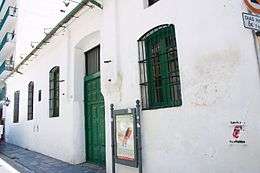
The criollo peoples promoted the Carlotist project, which tried to crown Charlotte of Spain, sister of Ferdinand, as Regent of the Spanish territories in the Americas, under a Constitutional monarchy. The project did not achieve success. The news of the creation of the Junta of Seville was seen by both criollos and peninsulars as a chance to create similar governments locally, but they had different perspectives on the political line such governments should have. Javier de Elío, governor of Montevideo and allied with Álzaga, created a Junta in the city. Álzaga set off a mutiny to do the same in Buenos Aires, but the forces under the command of Cornelio Saavedra defeated it and kept Liniers in power. Álzaga was jailed and the military bodies that took part in the mutiny were dissolved, which left only military bodies loyal to the criollos.
The Junta of Seville appointed a new viceroy, Baltasar Hidalgo de Cisneros. Some Criollos proposed Liniers to resist the replacement with the forces under his command. It was considered that only a rightful king could appoint viceroys, and despite the circumstances of his designation Liniers had been confirmed in office by Charles IV; whereas Cisneros, appointed just by the Junta, may have lacked such legitimacy. However, Liniers rejected the proposal, and gave up government without resistance.
After leaving government, he retired from politics and moved to Córdoba province, settling in the town of Alta Gracia. However, he came out of his retirement shortly after, when news of the May Revolution arrived to the province.
Counterrevolution and death

The governor of Córdoba, Juan Antonio Gutiérrez de la Concha, called for a meeting of the social elite of Córdoba, Liniers included, in order to discuss reactions towards the Primera Junta. At this time, Liniers's father-in-law, Martín de Sarratea, wrote a letter to ask him to stay away from the counterrevolution, which he refused in the name of honor and respect to his word.
The Córdoba Cabildo gave recognition instead to the Regency Council of Cádiz, and Cisneros secretly gave authorization to Liniers to raise the viceroyalty against the Junta.[19] Liniers wrote to other Royalist leaders, trying to organize the forces to fight against Buenos Aires. The Junta decided that, among the many enemies that could threaten it, Córdoba was the most dangerous, so an army led by Ortiz de Ocampo was sent to fight against it. However, there was no fighting: the counterrevolutionary army was severely damaged by espionage, desertions, and sabotage. The mere proximity of the troops from Buenos Aires caused the complete dispersion of the army gathered by Liniers. Liniers and the other top personnel of the counterrevolution tried to flee in multiple directions, but Ocampo captured them all.
Ocampo refused to execute the prisoners, aware of their popularity, so he delivered them to Buenos Aires as prisoners instead. The Junta feared the effect that the entry of Liniers into the city might have, so Juan José Castelli was sent, with orders to replace Ocampo and execute the prisoners. The execution took place at Cabeza de Tigre, on the border between Santa Fe and Córdoba.
Legacy
Liniers had been recognized in life with a street of Buenos Aires named after him, after the triumph against the British Invasions. However, after the counterrevolution and the new number of heroes of the Argentine War of Independence, most names of such streets were modified in 1822, during the government of Martín Rodríguez. The former Liniers street consisted of the modern Defensa and Reconquista streets.[20] The higher recognition to the heroes of the War of Independence stayed, but Liniers got renewed recognition with time. The Buenos Aires neighborhood of Liniers is named after him, as well as the Santiago de Liniers municipality in the Misiones Province.
In 1861, Queen Isabella II of Spain formally requested Liniers's body from the Argentine Government. The remains were brought back to Spain and solemnly buried in the Panteón de Marinos Ilustres of the island of San Fernando, Cádiz. At this time, Liniers's descendants received the hereditary title of "Conde de la Lealtad" (Count of Loyalty).
His house at Alta Gracia was abandoned after his death, and bought in 1820 by José Manuel Solares. His family kept it for a long time, until it was expropriated in 1969 and turned into a museum in 1977. It was declared heritage of humanity by UNESCO on December 2, 2000.[21]
- One of the best known portraits of Liniers is La Reconquista de Buenos Aires, by Charles Fouqueray.
- El último virrey, a novel by Horacio Salduna, is based on Liniers' life.
Bibliography
- De Titto, Ricardo (2010). Hombres de Mayo. Buenos Aires: Grupo Editorial Norma. pp. 25–50. ISBN 978-987-545-584-9.
- Groussac, Paul (1999). Santiago de Liniers: Conde de Buenos Aires. Buenos Aires: Ciudad Argentina. ISBN 987-507-114-5.
- Ortega, Exequiel (1944). Liniers, Una vida frente a la gloria y a la adversidad. Buenos Aires: Editorial Claridad.
- Crónica Histórica Argentina. Codex. 1968.
- Balmaceda, Daniel (2010). Historias de corceles y de acero. Buenos Aires: Sudamericana. ISBN 978-950-07-3180-5.
- Luna, Félix (2000). Grandes protagonistas de la historia argentina: Santiago de Liniers. Buenos Aires: Grupo Editorial Planeta. ISBN 950-49-0357-6.
- Jacques de Liniers, Général & Vice-Roi de La Plata, par Le Marquis de Sassenay, Editions de La Reconquête, Asuncion 2011.
- Demaría, Gonzalo; Molina de Castro, Diego (2001). Historia Genealógica de los Virreyes del Río de la Plata (in Spanish). Buenos Aires: Junta Sabatina de Especialidades Históricas. ISBN 987-1042-01-9.
References
| Wikimedia Commons has media related to Santiago de Liniers. |
- ↑ AquiMontserrat.com
- ↑ Groussac, p. 30
- ↑ Groussac, p. 29
- ↑ Groussac, pp. 30–32
- ↑ Demaría & Molina de Castro 2001, p. 322-325.
- ↑ Groussac, pp. 32–33
- ↑ Groussac, pp. 33–34
- ↑ Groussac, pp. 34–35
- ↑ Groussac, pp. 35–36
- ↑ Groussac, p. 36
- ↑ Groussac, pp. 39–41
- 1 2 Trofeos de la Reconquista de la Ciudad de Buenos Aires en el Año 1806 (in Spanish). Buenos Aires: Litografía, Imprenta y Encuadernación de Guillermo Kraft. 1882.
- ↑ De Titto, p. 41
- ↑ Palombo, Guillermo. Las Banderas Británicas tomadas en Buenos Aires el 5 de Julio de 1807. (in Spanish).
- ↑ De Titto, p. 42
- ↑ De Titto, p. 43
- ↑ de Titto, p. 45
- ↑ Abad de Santillán, Diego (1965). "Virreyes del Río de la Plata". Historia Argentina (in Spanish). Buenos Aires: TEA (Tipográfica Editora Argentina). p. 212.
Spanish: Nada había en la conducta del virrey que se prestase a tergiversaciones, pero no obstante, españoles peninsulares de Buenos Aires y de Montevideo persistieron en sus planes conspirativos contra él, por extranjero y por francés.
line feed character in
English: There was nothing in the viceroy's conduct that lent itself to misrepresentations, but nevertheless, the peninsular Spaniards of Buenos Aires and Montevideo insisted in their conspiratorial plans against him, for being a foreigner and French.|quote=at position 237 (help) - ↑ De Titto, p. 48
- ↑ Balmaceda, p. 267
- ↑ Santiago de Liniers, de virrey a estanciero
| Preceded by Rafael de Sobremonte |
Viceroy of the Río de la Plata 1807–1809 |
Succeeded by Baltasar Hidalgo de Cisneros |

